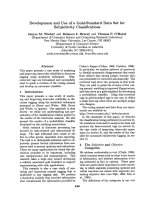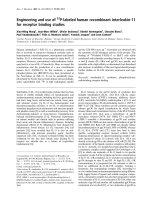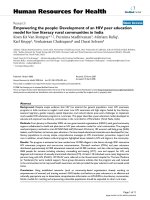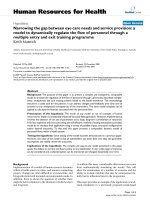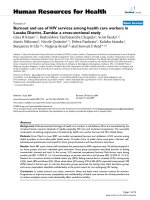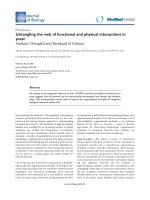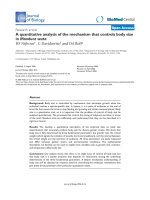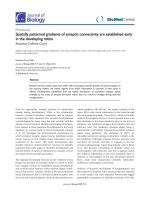Báo cáo sinh học: " Generalizing the use of the canonical transformation for the solution of multivariate mixed model equations" doc
Bạn đang xem bản rút gọn của tài liệu. Xem và tải ngay bản đầy đủ của tài liệu tại đây (895.47 KB, 20 trang )
Original
article
Generalizing
the
use
of
the
canonical
transformation
for
the
solution
of
multivariate
mixed
model
equations
V
Ducrocq
H
Chapuis
1
Station
de
génétique
quantitative
et
appliquée,
Institut
national
de
la
recherche
agronomique,
78352
Jouy-en-Josas
cedex;
2
Betina
S61ection,
Le
Beau
Chene,
Tr6dion,
56250
Elven,
France
(Received
4
December
1996;
accepted
27
March
1997)
Summary -
The
canonical
transformation
converts
t
correlated
traits
into
t
phenotypi-
cally
and
genetically
independent
traits.
Its
application
to
multiple
trait
BLUP
genetic
evaluations
decreases
computing
requirements,
increases
the
convergence
rate
of
iterative
solvers
and
simplifies
programming.
This
paper
presents
alternative
ways
to
retain,
at
least
partly,
these
desirable
characteristics
in
situations
where
the
canonical
transformation
is
theoretically
impossible:
when
some
traits
are
missing
in
some
animals
(including
when
a
reduced
animal
model
is
used),
when
more
than
one
random
effect
is
included
in
the
model
and
when
different
traits
are
described
by
different
models.
genetic
evaluation
/
mixed
model / computing
algorithm
/
multiple
trait
/
animal
model
Résumé -
Généralisation
de
l’utilisation
de
la
transformation
canonique
pour
la
résolution
des
équations
du
modèle
mixte
multicaractère.
La
transformation
canoni-
que
remplace
t
caractères
corrélés
par
t
caractères
génétiquement
et
phénotypiquement
indépendants.
Son
application
dans
des
évaluations
génétiques
de
type
BL UP
multi-
caractères
diminue
les
besoins
informatiques,
accroît
la
vitesse
de
convergence
d’algo-
rithmes
de
résolution
itérative
et
simplifie
la
programmation.
Cet
article
présente
di
f
fé-
rentes
manières
de
conserver
au
moins
partiellement
ces
caractéristiques
favorables
dans
les
situations
où
la
transformation
canonique
est
théoriqv,ement
impossible,
c’est-à-dire
quand
certains
caractères
sont
manquants
pour
certains
animaux
(y
compris
lorsqu’un
modèle animal
réduit
est
v.tilisé),
quand plus
d’un
effet
aléatoire
est
inclus
dans
le
modèle
et
quand
différents
caractères
sont
décrits
par
différents
modèles.
évaluation
génétique
/
modèle
mixte
/
algorithme
de
calcul
/
évaluation
multi-
caractères
/
modèle
animal
INTRODUCTION
In
routine
genetic
evaluations,
theoretical
considerations
suggest
that
in
situations
where
records
can
be
described
as
linear
functions
of
fixed
and
random
effects,
best
linear
unbiased
prediction
(BLUP)
of
genetic
effects
based
on
a
multiple
trait
animal
model
should
be
used
(Henderson
and
Quaas,
1976;
Foulley
et
al,
1982;
Quaas,
1984;
Schaeffer,
1984).
The
inclusion
of
the
known
relationship
between
traits
in
a
joint
analysis
of
these
traits
increases
the
amount
of
information
available
and
as
a
result,
improves
the
accuracy
of
prediction
and
corrects
potential
biases
resulting
from
selection.
van
der
Werf
et
al
(1992)
and
Ducrocq
(1994a)
review
the
benefits
to
be
drawn
from
a
multiple
trait
BLUP
genetic
evaluation.
Flexible
general
purpose
packages,
eg,
PEST
(Groeneveld
et
al,
1990;
Groeneveld
and
Kovac,
1990)
exist
and
are
successfully
used
to
solve
complex
multiple
trait
evaluations.
However,
the
simple
iterative
algorithms
commonly
implemented
in
such
packages
can
be
extremely
slow
to
converge
when
traits
are
missing
for
some
animals
or
when
several
random
effects
or
groups
of
unknown
parents
are
defined
in
the
model
(Groeneveld
and
Kovac,
1992;
Ducrocq,
1994a,
b).
Although
generally
acceptable
for
data
files
of
moderate
size,
slow
convergence
can
become
a
limiting
factor
for
routine
national
evaluations.
In
the
particular
case
when
the
same
model
with
only
one
random
(genetic)
effect
applies
to
all
traits
and
no
records
are
missing,
a
canonical
transformation
of
the
t records
of
each
animal
into
uncorrelated
records
replaces
the
large
system
of
multiple
trait
mixed model
equations
with
a
set
of
t
simpler
univariate
systems
(Foulley
et
al,
1982;
Quaas,
1984;
Arnason,
1986;
Thompson
and
Meyer,
1986;
Jensen
and
Mao,
1988;
Ducrocq
and
Besbes,
1993).
The
resulting
reduction
in
computing
costs
is
often
drastic.
However,
the
restrictions
on
the
model
and
data
structure
required
for
the
implementation
of
the
canonical
transformation
are
rarely
fulfilled
in
practice.
Other
transformations
have
been
proposed
when
some
traits
are
missing
(Pollak
and
Quaas,
1982;
Quaas,
1984)
but
it
was
found
that
a
strategy
where
missing
values
are
iteratively
replaced
by
their
expectation
and
therefore
retaining
the
possibility
to
implement
the
canonical
transformation
is
clearly
superior
(Ducrocq
and
Besbes,
1993;
Ducrocq,
1994a,
b).
The
purpose
of
this
paper
is
to
demonstrate
that
the
basic
objective
of
the
canonical
transformation,
ie,
the reduction
of
a
large
linear
system
of
equations
into
sets
of
smaller,
sparser
systems
can
be
achieved
in
even
more
general
situations,
eg,
with
different
models
for
each
trait
or
with
more
than
one
random
effect
other
than
the
residual.
For
the
sake
of
completeness,
the
simple
canonical
transformation
is
briefly
described
with
and
without
missing
values
on
some
traits.
An
extension
of
the
above-mentioned
strategy
for
the
missing
values
case
to
reduced
animal
models
is
also
presented.
MULTIPLE
TRAIT
MIXED
MODEL
EQUATIONS
First,
consider
the
general
situation
encountered
in
multiple
trait
genetic
evalua-
tions.
For
each
trait
i,
i =
1, t,
assume
the
linear
model:
where
yi
is
the
vector
of
records
for
trait
i;
bi
and
ai
are
vectors
of
fixed
and
random
effects
and
Xi
and
Zi
are
the
corresponding
incidence
matrices.
Here,
the
only
assumption
is
that
no
more
than
one
random
effect
other
than
the
residual
ei
is
considered
in
the
model.
The
variance-covariance
structure
for
the
random
effects
is
summarized
as
follows:
Concatenating
the
random
(genetic)
effects
and
the
residuals
for
all
traits
into
vectors
a
and
e,
respectively,
the
G
ij
and
RZ!
blocks
are
grouped
into
matrices
G
=
Var(a)
and
R
=
Var(e).
The
(i, j)
blocks
of
the
inverse
matrices
G-’
and
R-
1
are
denoted
G
ij
and
R
ij
,
respectively.
The
submatrices
G
ij
and
R2!
are
functions
of
the
pedigree
and
data
structures
and
of
Go
and
Ro,
the
genetic
and
residual
variance-covariance
matrices
between
traits.
The
general
form
of
the
mixed
model
equations
is:
The
number
of
equations
and
the
memory
requirements
for
such
systems
increase
with
t
and
t2,
respectively.
Iterative
solvers
can
be
used
but
they
are
relatively
complex
to
implement
in
the
general
case.
More
importantly,
convergence
rate
can
be
extremely
slow
(Arnason,
1986;
Groeneveld
and
Kovac,
1992;
Reents
and
Swalve,
1991).
CANONICAL
TRANSFORMATION
In
this
section,
we
consider
the
particular
case
where
there
are
no
missing
records,
ie,
each
one
of
the
recorded
animals
has
a
record
on
each
of
the
t traits,
and
the
same
model
applies
to
all
traits.
Let
y
=
(Y’
Y
’
y’)’
be
the
vector
including
all
records
for
all
traits
and
b
=
(b
bt)’
be
the
vector
of
fixed
effects.
Each
vector
yi
is
of
size
N
Define
Q
to
be
a
matrix
such
that
QGoQ
’
=
D -
1,
where
D
is
a
diagonal
matrix,
and
QRoQ’
=
It.
Such
a
matrix
always
exists.
A
way
to
compute
Q
can
be
found,
eg,
in
Quaas
(1984)
or
Ducrocq
and
Besbes
(1993).
Quaas
(1984)
described
different
ways
to
simplify
the
multivariate
system
[3]
transforming
its
coefficient
matrix
into
a
block-diagonal
matrix.
A
first
approach
consists
in
applying
a
linear
transformation:
to
the
data
vector
y
and
to
manipulate
the
model
of
analysis
accordingly.
This
leads
to
the
transformed
model:
where
bQ
=
(Q
Q9
IB
)b,
aQ
=
(Q
Q9
I,
V
* )a
and
eQ
=
(Q
Q9
IN
)e.
B and
N*
are
the
dimensions
of
bi
and
ai,
respectively.
Then:
Since
D
and
It
are
diagonal
t x
t matrices,
the
resulting
system
of
mixed model
equations
is
block-diagonal
and,
therefore,
the
solutions
for
the
fixed
and
random
effects
for
each
transformed
trait
i can
be
obtained
solving
the
univariate
system:
where d
i
is
the
ith
diagonal
element
of
D.
The
solutions
on
the
original
scale
are
obtained
by
simple
back-transformation:
For
later
use,
we
will
now
describe
another
enlightening
way
of
obtaining
this
result
(Quaas,
1985,
pers
comm),
through
matrix
manipulation
of
the
multivariate
mixed
model
equations
corresponding
to
model
!4!:
Rewrite
system
[12]
as
Cu
=
W’y
and
define
S =
(
Q
Q9 0
IB
Q
Q9
0
IN*
) and
S*
=
Q
Q9
IN.
Premultiply
both
sides
of
the
system
by
S-’
=
(S-’)’
and
insert
I(
B+Ar*
)t
=
S-
1S
in
the
left-hand
side
and
I
Nt
=
S*
-’S
*
in
the
right-hand
side.
This
results
in:
and
is
equal
to:
which
simplifies
again
into
univariate
systems
!14!.
Canonical
transformation
and
reduced
animal
model
The
canonical
transformation
applies
without
modifications
to
multivariate
reduced
animal
models
(RAM;
Quaas
and
Pollak,
1981).
This
will
be
illustrated
here
in
order
to
introduce
notations
for
later
use.
Let
the
indices
(p)
and
(n)
refer
to
parent
and
non-parent
animals
(N
P
+
Nn
=
N*
).
One
can
rewrite
model
[1]
as:
where
K!n!
is
a
matrix
relating
records
of
non-parent
animals
to
their
parents.
A
typical
row
of
matrix
K(!)
has
two
non-zero
elements
equal
to
0.5
in
the
columns
corresponding
to
parents.
For
the
t traits,
with
records
ordered
within
trait:
The
part
of
e*
corresponding
to
non-parents
includes
the
residual
effect
e(
n)
as
well
as
the
mendelian
sampling
contribution
!!n!.
Let
Var(e
*)
=
R*.
If
em
represents
the
t elements
of
the
residual
vector
e*
for
a
particular
animal
m,
we
have:
When
parents
are
not
inbred,
8m
=
0.75
or
8m
=
0.5
depending
on
whether
only
one
or
both
parents
are
known.
Let
Dn
be
the
diagonal
matrix
of
size
Nn
with
diagonal
element
6m
If
App
is
the
relationship
matrix
between
parents,
we
have:
Then,
after
transformation
of
the
data
y
! >
yQ
(or
after
matrix
manipulations
similar
to
!13!),
system
[21]
can
be
partitioned
into
t univariate
’RAM’
systems
to
solve.
For
the
transformed
trait
i and
defining
SZ!!!
=
INn
+
diD
n:
MISSING
VALUES
As
previously
indicated,
the
transformation
[6]
or
the
matrix
manipulation
[13]
require
identical
incidence
matrices
X
and
Z
for
each
trait.
Therefore
they
cannot
be
directly
implemented
when
some
recorded
animals
have
missing
values
for
some
traits.
A
simple
strategy
to
avoid
this
constraint
has
been
proposed
by
Ducrocq
and
Besbes
(1993)
and
Ducrocq
(1994a,
b)
and
is
briefly
reviewed
here.
The
underlying
idea
is
to
iteratively
replace
the
missing
values
by
their
expectation
given
our
current
knowledge
of
all
parameters
and
to
solve
the
resulting
sytem
as
if
they
were
not
missing,
ie,
applying
the
canonical
transformation.
It
can
be
algebraically
shown
that
this
technique
leads
to
the
same
solutions
for
fixed
and
random
effects
as
the
usual
general
approach.
A
formal
justification
results
from
the
use
of
the
expectation-maximization
(EM)
algorithm
of
Dempster
et
al
(1977).
Using
subscripts
a
and
{3
for
observed
and
missing
observations,
respectively,
and
assuming
that,
given
a
and
b,
the
complete
(=
augmented)
data
vector
y
=
(y!,
y) ) ’
follows
a
multivariate
normal
distribution
with
mean
(It (9 X)b+ (It 0 Z)a,
the
estimation
of
b
and
the
prediction
of
a
require
the
knowledge
of
the
vector
of
sufficient
statistics
T
(y)
where:
The
vector
y,
3
being
unknown,
we
replace
T
(y)
at
iteration
k
by
its
expectation
(E
step):
where
for
observed
records: .
k
(k)
=
ya
and
for
animal
m
with
missing
records:
In
the
above
formula,
R
om
,
aa
and
R
Om
,
¡3a
are
obtained
from
Ro
by
choosing
the
rows
and
columns
corresponding
to
missing
and
observed
traits
for
animal
m.
Xm
¡3
(respectively,
X
ma
)
are
obtained
from
(It
0
X)
by
choosing
rows
corresponding
to
missing
(respectively,
observed)
traits
for
animal
m.
Similarly,
am,
and
a&dquo;
La
are
the
elements
of
am
corresponding
to
missing
and
observed
traits.
The
M
step
consists
in
solving
the
mixed model
equations
in
order
to
obtain
new
values
b!!+1!
and
a!!+1!
for
b and
a.
This
is
much
simpler
to
implement
than
in
the
general
case
because
now
a
canonical
transformation
is
possible:
from
the
records
actually
observed
and
the
prediction
of
the
missing
ones
at
the
current
EM
iteration,
transformed
records
on
the
canonical
scale
can
be
computed.
After
solution
of
the
mixed
model
equations
on
the
canonical
scale
and
backsolution
on
the
original
scale,
new
predictions
for
the
missing
values
are
made
and
this
iterative
scheme
is
repeated
until
convergence.
In
practice,
it
is
not
necessary
to
go
back
to
the
original
scale
as
updating
can
be
done
on
the
canonical
scale.
Consider
that
all
traits
for
animal
m
have
been
ordered
such
that
observed
traits
precede
missing
ones:
C y&dquo;’’a J .
If
this
is
not
the
case,
re-order
ym,
Q
and
R.
Partition
Ym¡3
Q
=
((aa
Q¡3)
and
Q-
1
= C Q
a
J .
Then,
the
vector
of
observations
for
animal
m
Q,3
on
the
transformed
scale
at
iteration
(k)
is:
but
we
have:
where
bQ
.&dquo;,,
is,
on
the
transformed
scale,
the
vector
of
fixed
effects
pertaining
to
animal
m.
Finally:
where
Xm
represents
the
rows
of
It
0
X
pertaining
to
animal
m.
The
matrices
JQ!
(of
size
t x
ta)
and
J
Q2
(of
size
t x
t)
depend
on
the
missing
pattern
only,
and
they
are
computed
only
once
for
use
at
each
iteration.
Furthermore,
each
EM
step
can
be
interlaced
with
the
iterative
procedure
used
to
solve
the
mixed model
equations.
This
results
in
large
savings
in
computing
time.
Application
to
reduced
animal
models
(following
a
suggestion
from
R
Thompson)
With
the
previous
approach,
in
RAM
situations,
it
is
necessary
to
predict
y;
;,b
for
all
non-parent
animals.
This
requires
in
[25]
the
knowledge
of
a!!>.
This
is
in
contradiction
to
the
original
purpose
of
using
a
reduced
animal
model,
which
is
to
solve
a
smaller
system
of
mixed
model
equations
with
the
additive
genetic
values
of
the
parent
animals
only.
To
avoid
the
computation
of
non-parent
animals’
genetic
values,
one
can
replace
the
E step:
L
1. 1
1
Then,
for
a
non-parent
m
with
missing
records,
and
with
parents
’sire’
and
’dam’:
Again,
Rp.&dquo;,,
aa
and
7!.oTn,/3a;
defined
in
[17]
and
[18]
are
obtained
from
7Zo&dquo;,
by
choosing
the
rows
and
columns
corresponding
to
missing
and
observed
traits.
These
predicted
missing
values
influence
the
right-hand
side
of
the
RAM
equa-
tions,
which
after
canonical
transformation
is
of
the
form:
After
each
solution
of
the
reduced
system
of
equations,
or
after
each
iteration
completed,
the
missing
terms
in
YQi(P)
and
YQi(n)
of
[30]
are
computed
again
given
the
current
values
of
b
&dquo;
and
a
(’)
Q
(P)Q*
MORE
THAN
ONE
RANDOM
EFFECT
The
second
necessary
condition
in
order
to
apply
the
regular
canonical
transfor-
mation
is
the
existence
of
only
one
random
effect
other
than
the
residual.
In
this
section,
this
requirement
will
be
relaxed.
Consider
for
example
a
model
with
a
di-
rect
additive
genetic
effect
and
a
maternal
genetic
effect.
Assume
the
same
model
for
all
traits
(no
missing
values):
where
m
is
the
vector
of
maternal
effects,
M
the
corresponding
incidence
matrix
and:
The
corresponding
mixed
model
equations
can
be
written:
Simultaneous
diagonalization
A
straightforward
extension
of
the
canonical
transformation
was
suggested
by
Lin
and
Smith
(1990)
in
a
particular
situation:
if
G!,&dquo;,,
=
G&dquo;,,
a
=
0
and
G
aa
,
Gm
m
and
Ro
are
proportional,
then
it
is
possible
to
find
a
matrix
Q
such
that,
after
a
transformation
similar
to
(6!:
The
resulting
system
of
mixed
model
equations
is
block-diagonal
and
simplifies
to
t
univariate
systems:
Again,
this
result
can
be
obtained
via
a
manipulation
of
the
system
of
equations
as
in
[13].
The
conditions
required
to
diagonalize
three
(or
more)
covariance
matrices
are
rather
drastic.
Misztal
et
al
(1995)
clearly
showed
that
accurate
results
can
still
be
obtained
when
the
true
covariance
matrices
are
replaced
with
simultaneously
diagonisable
approximations
of
these
matrices.
However,
this
approach
is
not
applicable
when
the
random
effects
are
correlated
(Gam
-
I-
0).
Block-iterative
canonical
transformation
A
more
general
strategy
consists
in
solving
[34]
block-iteratively
(Hackbusch,
1994).
The
diagonal
blocks
are
chosen such
that
the
canonical
transformation
can
be
applied.
Let
Q
and
P
be
the
transformation
matrices
such
that:
Using
these
matrices,
a
manipulation
similar
to
[13]
can
be
performed
to
sim-
plify
[34].
Define:
Premultiplying
both
sides
by
SQP
and
inserting
the
appropriate
identity
matrices
between
the
coefficient
matrix
and
the
vector
of
unknowns
on
the
one
hand
and
before
the
data
vector
on
the
right-hand
side
on
the
other
hand,
we
obtain:
Equation
[40]
simplifies
to:
At
each
iteration,
one can
solve
the
univariate
systems:
DIFFERENT
MODELS
FOR
DIFFERENT
TRAITS
A
third
requirement
for
the
applicability
of
the
canonical
transformation
is
the
use
of
the
same
model
for
each
trait.
Again,
several
strategies
exist
to
at
least
partly
retain
the
benefits
of
the
transformation
for
computational
simplicity.
For
simplicity,
assume
here that
in
model
[1],
the
incidence
matrices
Zi
=
Z
are
the
same
for
all
traits
i (no
missing
values
on
recorded
animals)
but
that
the
incidence
matrix
Xi
can
vary
from
one
trait
to
another.
Block-iterative
approach
In
the
general
expression
(3!,
one
can
isolate
in
the
coefficient
matrix
the
diagonal
blocks
corresponding
to
the
fixed
effects
on
the
one
hand
and
to
the
random
effects
on
the
other.
The
off-diagonal
blocks
are
moved
to
the
right-hand
side
after
multiplication
by
the
current
solutions
of
the
corresponding
effects.
For
the
fixed
effects
part,
the
system
remains
multivariate:
But
for
the
random
effects
block,
it
is
possible
to
take
advantage
of
the
fact
that
the
incidence
matrix
is
the
same
for
all
traits:
where
y¡
k+1J
=
yi
-
Xb¡k+1J.
Applying
the
regular
canonical
transformation
(as
in
!6!)
to
(47!,
the
random
effect
block
becomes
a
set
of
t univariate
systems:
Gengler
and
Misztal’s
approach
Gengler
and
Misztal
(1996)
proposed
an
approach
that
makes
use
of
the
algorithm
described
for
the
missing
values
case
(note:
this
approach
was
also
found
and
used
by
Goddard
(1995,
pers
comm)).
Their
method
is
better
illustrated
using
a
two-trait
example:
Here,
the
vector
f1
(with
associated
incidence
matrix
F)
refers
to
fixed
effects
influencing
trait
1
only,
h2
(matrix
H)
refers
to
those
influencing
trait
2
only
and
b
(matrix
X)
includes
effects
affecting
both.
Consider
for
example
an
animal
m
with
two
recorded
traits:
Gengler
and
Misztal
(1996)
duplicate
all
records
and
define
a
complete
model
where
all
fixed
effects
influence
all
traits:
For
the
animal
m
above,
this
means
the
use
of four
records,
two
of
them
being
considered
missing:
Here,
dum
refers
to
a
dummy
level
defined
for
missing
records
only
and
different
from
any
level
corresponding
to
observed
records.
After
this
artificial
modification,
the
same
incidence
matrices
apply
to
all
traits
(for
the
first
and
second
records
for
each
trait
in
[52],
respectively)
and
a
regular
canonical
transformation
can
be
performed
using
the
approach
described
in
the
previous
section
to
include
missing
records.
No
additional
coding
is
required
as
long
as
the
initial
code
accepts
multiple
records.
All
records
are
analyzed
with
the
proper
model.
An
approach
using
constraints
on
unnecessary
effects
We
will
slightly
generalize
Gengler
and
Misztal’s
example
described
in
[49).
Consider
two
groups
of
traits:
The
idea
here
is
to
define
the
complete
model
[51]
for
all
traits
and
to
solve
the
resulting
mixed model
equations
under
the
constraints:
The
full
system
of
mixed
model
equations
is:
Applying
once
more
a
block-iterative
strategy
for
the
solution
of
this
system,
we
can
first
solve:
This
system
has
exactly
the
same
form
as
described
in
[12]
and
can
be
trans-
formed
into
a
set
of
t
smaller
systems
by
canonical
transformation.
The
other
two
blocks
to
solve
are:
The
constraints
will
be
applied
on
these
smaller
systems.
For
example,
for
the
f
block,
we
want
to
solve:
Note
that
the
set
of
constraints
can
be
written
as:
To
is
a
diagonal
t
x
t
matrix
with
diagonal
element
equal
to
one
for
each
effect
to
be
constrained
to
0
and
equal
to
0
otherwise.
Solving
[60]
is
equivalent
to
minimizing
the
expression:
under
the
constraint
(To
0
If)
f
=
0.
Constrained
minimization
problems
can
be
solved
using
Lagrange
multipliers.
Let
71
be
a
vector
of Lagrange
multipliers.
Taking
the
derivatives
of
U
+
a’(T
0
If
)f
with
respect
to
f
and
71,
we
get
the
following
linear
system:
Now,
premultiplying
both
sides
by:
and
inserting:
the
system
becomes:
System
[64]
is
of
the
form
and
has
a
solution
equal
to:
Given
the
form
of
C
and
T
and
in
particular
C-’T’
=
Q-
T
To
Q9
(F’F)-’
=
T’C-’,
it
follows
C-’T’(TC-’T’)-T
=
T’(TT’)
-T
and
[65]
leads
to
the
expression:
which
can
be
written
more
simply
as:
where
Wo
is
a
t
x
t matrix
computed
only
once
and
f
oQ
are
the
unconstrained
solutions.
These
unconstrained
solutions
are
obtained
solving
t simple
univariate
systems.
If
more
than
one
effect
is
included
in
f,
the
inverse
of
a
full
rank
submatrix
of
F’F
is
used
in
[66]
or
an
iterative
approach
is
used
to
obtain
f¿!+1).
.
A
numerical
example
of
the
algorithm
is
given
in
the
Appendix.
DISCUSSION
The
systematic
use
of
a
canonical
transformation
to
solve
multiple
trait
mixed
model
equations
is
desirable
for
several
reasons,
all
relying
on
the
computational
advantages
it
offers.
The
resulting
system
is
much
sparser.
Increased
sparsity
has
a
beneficial
effect
on
the
convergence
rate
of
iterative
methods.
This
has
been
repeatedly
found
in
univariate
evaluations
(eg,
when
an
equivalent
model
is
used
to
increase
the
sparsity
of the
coefficient
matrix
when
groups
of
unknown
parents
are
defined
(Quaas,
1988))
as
well
as
for
multivariate
analyses
(Pollak
and
Quaas,
1982;
Ducrocq
and
Besbes,
1993).
As
a
result
of
the
block-diagonal
structure
of
the
coefficient
matrix,
the
system
breaks
down
to
several
systems
of
smaller
size.
Again,
this
generally
leads
to
faster
convergence
in
univariate
(eg,
with
reduced
animal
models)
as
well
as
in
multivariate
situations
(Arnason,
1986;
Ducrocq,
1994a,
b).
Programming
is
easier,
since
each
system
is
equivalent
to
a
single-trait
analysis.
Programming
can
be
made
more
efficient:
iteration
on
data
(Schaeffer
and
Kennedy)
may
be
replaced
by
(possibly
partial)
storage
of
the
coefficient
matrices
in
core.
The
system
being
smaller
and
sparser,
a
direct
solution
may
become
feasible
in
some
cases,
possibly
on
parts
of
the
system
only.
The
search
for
optimized
iterative
algorithms
(eg,
with
optimum
relaxation
factors
(Misztal
and
Gianola,
1987)
may
become
worthwhile.
The
estimation
of
variance
components
is
greatly
simplified
and
less
computer
intensive
(Meyer,
1985;
Jensen
and
Mao,
1988).
In
this
paper,
it
was
shown
that
there
are
ways
to
retain
at
least
partly
these
computational
advantages
when
the
three
main
requirements
for
the
regular
canonical
transformation
to
be
feasible
are
not
fulfilled.
When
data
are
missing,
one
can
replace
the
missing
records
at
each
iteration
by
their
expected
values
given
the
current
parameters;
the
extra
coding
is
minimal;
the
potential
drawbacks,
such
as
the
need
to
backsolve
for
each
non-parent
solution
when
a
reduced
animal
model
is
used
(Ducrocq
and
Besbes,
1993),
can
be
avoided.
When
more
than
one
random
effect
other
than
the
residual
is
included
in
the
model
and
a
simultaneous
diagonalization
of
all
the
covariance
matrices
between
traits
is
not
possible,
a
canonical
transformation
can
still
be
applied
to
the
diagonal
block
corresponding
to
each
random
effect.
Block
iteration
is
a
well-known
extension
of
iterative
techniques
(Hackbusch,
1994).
Although
the
procedure
proposed
here
is
relatively
simple,
it
is
not
guaranteed
that
such
a
strategy
is
always
more
efficient
than
when
other
partitions
of
the
coefficient
matrix
in
[33]
are
used.
Quaas
(pers
comm)
suggests
than
in
some
cases,
it
may
be
better
to
sort
the
equations
in
[33]
by
traits
within
animal
and
to
treat
together
all
the
equations
referring
to
the
same
animal
in
a
block-iterative
procedure.
Direct
and
maternal
effects
of
each
animal
are
then
computed
jointly
instead
of
separately
as
in
[42]
and
(43!.
The
behavior
of
both
strategies
needs
to
be
compared
in
real-life
situations.
This
was
not
considered
here.
When
the
models
describing
each
trait
differ,
three
alternatives
are
proposed.
The
first
one
relies
on
the
same
idea
developed
in
the
case
with
more
than
one
random
effect:
one
can
isolate
in
the
mixed
model
equations
a
block
on
which
the
canonical
transformation
can
be
applied.
Most
often,
this
will
represent
by
far
the
largest
block,
corresponding
to
additive
genetic
values.
However,
this
implies
a
specific
coding
for
the
solution
of
the
remaining
multivariate
part
[46].
The
second
approach
(Gengler
and
Misztal,
1996)
has
the
advantage
of
being
applicable
without
additional
coding.
Its
drawbacks
are
the
large
increase
in
the
size
of
the
data
file
(the
initial
size
is
multiplied
by
as
many
times
as
there
are
distinct
models)
and
the
slower
convergence
resulting
from
the
large
number
of
missing
records
whose
values
have
to
be
computed
at
each
iteration.
It
is
not
known
whether
convergence
is
always
guaranteed
in
practice.
The
third
alternative
consists
of
creating
a
complete
model
including
all
fixed
effects
of
interest
and
constraining
to
zero
the
solutions
of
the
unwanted
effects
for
each
trait.
Equation
[67]
illustrates
the
fact
that
this
constraint
is
easy
to
implement.
Our
limited
experience
indicates
that
convergence
is
reached
at .about
the
same
rate
as
when
the
complete
model
is
applied
without
constraints.
It
should
be
noted,
however,
that
this
approach
imposes
a
block-iterative
solution
of
the
fixed
effects
one
block
at
a
time,
which
sometimes
may
be
much
less
efficient
than
a
simultaneous
solution
of
all
fixed
effects,
for
example
using
direct
methods.
Again,
it
was
not
our
intention
to
actually
compare
the
practical
performances
of
these
approaches
because
each
one
may
be
valuable
in
a
particular
context.
CONCLUSION
Multiple
trait
BLUP
equations
have
been
known
for
a
long
time
(Henderson
and
Quaas,
1976)
but
despite
the
desirable
theoretical
properties
of
the
resulting
predictions
and
the
huge
progress
in
computing
technology,
their
large
scale
application
is
far
from
systematic,
mainly
because
computing
time
remains
a
limiting
factor.
Some
of
the
strategies
presented
here
may
lack
the
flexibility
or
simplicity
required
for
easy
implementation
in
a
general
purpose
package
for
the
solution
of
multivariate
mixed
model
equations,
but
they
may
lead
to
invaluable
savings
in
computing
time
(Ducrocq
and
Besbes,
1993;
Ducrocq,
1994a,
b),
eg,
for
routine
national
genetic
evaluations.
These
savings
can
be
further
increased
by
the
use
of
more
efficient
single-trait
solvers
(Misztal
and
Gianola,
1987;
Ducrocq,
1992;
Carabano
et
al,
1992).
Obviously,
these
different
ways
to
generalize
the
use
of
the
canonical
transfor-
mation
can
be
extended
to
more
general
situations
with
simultaneously
missing
values,
different
models
and
more
than
one
random
effect.
The
strategies
proposed
are
complementary
and
can
be
combined
in
a
straightforward
manner.
One
excep-
tion
that
was
not
dealt
with
here
is
the
case
when
the
number
of
random
effects
considered
may
vary
between
traits,
for
example,
when
only
some
traits
may
have
repeated
observations
(implying
the
prediction
of
a
permanent
environment
effect)
or
may
be
under
the
influence
of
maternal
effects.
However,
the
basic
idea
developed
can
be
extended
to
such
a
case:
in
the
initial
system
of
mixed model
equations,
the
blocks
corresponding
to
each
particular
random
effect
can
be
isolated
and
a
canon-
ical
transformation
can
be
applied
to
each
of
these
blocks,
through
the
matrix
manipulation
described
in
!13!.
ACKNOWLEDGMENTS
The
authors
are
grateful
to
R
Thompson,
RL
Quaas,
M
Goddard
and
JJ
Colleau
for
their
useful
comments
and
suggestions
on
the
topic.
REFERENCES
Arnason
T
(1986)
Practical
aspects
in
the
estimation
of
breeding
values
for
multi-trait
selection.
World
Rev
Anim
Prod,
22,
75-84
Carabafio
MJ,
Najari
S,
Jurado,
JJ
(1992)
Solving
iteratively
the
Mixed
Model
equations.
Genetic
and
numerical
criteria.
In:
43rd
Annual
Meeting
of
the
EAAP,
Madrid,
Spain,
14-17
September
1992,
vol
I
(Abstr)
Dempster
AP,
Laird
NM,
Rubin
DR
(1977)
Maximum
likelihood
estimation
for
incomplete
data
via
the
EM
algorithm
(with
discussion).
J
Royal
S’tat
Soc
B
39,
1-38
Ducrocq
V
(1992)
Solving
animal
model
equations
through
an
approximate
incomplete
Cholesky
decomposition.
Gen
Sel
Evol
24,
193-209
Ducrocq
V
(1994a)
Approches
algorithmiques
du
mod6le
animal.
In:
Seminaire
Modèle
animal,
Department
de
g4!n!tique
animale,
Inra,
La
Colle-sv,r-Loup,
France,
26-29
septembre,
(JL
Foulley,
M
Mol6nat,
eds),
Inra,
France,
13-24
Ducrocq
V
(1994b)
Multiple
trait
prediction:
Principles
and
problems.
In:
5th
World
Congr
Genet
Appl
Livest
Prod,
Guelph,
7-12
August
1994,
University
of
Guelph,
Guelph,
vol
XVIII,
5WCGALP
Organizing
Commitee,
455-462
Ducrocq
V,
Besbes
B
(1993)
Solution
of
multiple
trait
animal
models
with
missing
data
on
some
traits.
J
Anim
Breed
Genet
110,
81-92
Foulley
JL,
Calomiti
S,
Gianola
D
(1982)
Ecriture
des
equations
du
blup
multicaract!res.
Ann
G6n6t
Sel
Anim
14,
309-326
Gengler
N,
Misztal
I
(1996)
Approximation
of
reliability
for
multiple-trait
animal
models
with
missing
data
by
canonical
transformation.
J
Dairy
Sci
79,
317-328
Groeneveld
E,
Kovac
M
(1990)
A
generalized
computing
procedure
for
setting
up
and
solving
mixed
linear
models.
J
Dairy
Sci
73,
513-531
Groeneveld
E,
Kovac
M
(1992)
Performance
characteristics
of
different
solving
strategies
in
multivariate
mixed
models.
Livest
Prod
Sci
30,
319-331
Groeneveld
E,
Kovac
M,
Wang
T
(1990)
PEST,
a
general
purpose
BLUP
package
for
multivariate
prediction
and
estimation.
In:
l!th
World
Congr
Genet
A
PP
I
Livest
Prod,
Edinburgh,
UK,
23-27
July
1990
(WG
Hill,
R
Thompson,
JA
Woolliams,
eds),
vol
XIII,
488-491
Hackbusch
W
(1994)
Iterative
Solution
of
Large
Sparse
Systems
of
Equations.
Springer-
Verlag,
New-York
Henderson
CR,
Quaas
RL
(1976)
Multiple
trait
evaluation
using
relatives’
records.
J Anim
Sci
43,
1188-1197.
Jensen
J,
Mao
I
(1988)
Transformation
algorithms
in
analysis
of
single
trait
and
of
multiple
trait
models
with
equal
design
matrices
and
one
random
effect.
J
Anim
Sci
66,
2750-
2761
Lin
CY,
Smith
SP
(1990)
Transformation
of
multitrait
to
unitrait
mixed
model
analysis
of
data
with
multiple
random
effects.
J
Dairy
Sci
73,
2494-2502
Meyer
K
(1985)
Maximum
likelihood
estimation
of
variance
components
for
a
multivariate
mixed model
with
equal
design
matrices.
Biometrics
41,
153-165
Misztal
I,
Gianola
D
(1987)
Extrapolation
and
convergence
criteria
with
Jacobi
and Gauss-
Seidel
iteration
in
animal
models.
J
Dairy
Sci
70,
2577-2584
Misztal
I,
Weigel
K,
Lawlor
T
(1995)
Approximation
of
estimates
of
(co)variance
com-
ponents
with
multiple-trait
restricted
maximum
likelihood
by
multiple
diagonalization
for
more
than
one
random
effect.
J
Dairy
Sci
78,
1862-1872
Pollak
EJ,
Quaas
RL
(1982)
Alternative
strategy
for
building
multiple
trait
mixed
model
equations.
J
Dairy
Sci
65,
102
(suppl 1)
Quaas
RL
(1988)
Additive
genetic
model
with
groups
and
relationships.
J
Dairy
Sci
71,
1338-1345
Quaas
RL
(1984)
Linear
prediction
in
BLUP
school
handbook.
In:
Use
of
Mixed
Models
for
Prediction
and
for
Estimation
of
(Co)variance
Components,
5-7
February
1984,
Animal
Genetics
and
Breeding
Unit,
Univ
of
New
England,
New
South
Wales
Quaas
RL,
Pollak
EJ
(1981)
Mixed
model
methodology
for
farm
and
ranch
beef
cattle
testing
programs.
J
Anim
Sci
51,
1277-1287
Reents
R,
Swalve
H
(1991)
Convergence
in
multi-trait
animal
models.
In:
42nd
Annual
Meeting
of
the
EAAP,
Berlin,
8-12
February,
vol
I,
160
(Abstr)
Schaeffer
LR
(1984)
Sire
and
cow
evaluation
under
multiple
trait
models.
J
Dairy
Sci
67,
1567-1580
Schaeffer
LR,
Kennedy
BW
(1986)
Computing
solutions
to
mixed
model
equations.
In:
3rd
World
Congr
Genet
Appl
Livest
Prod,
Lincoln,
Nebraska,
USA,
16-22
July
1986,
vol
XII,
382-393
Thompson
R,
Meyer
K
(1986)
A
review
of
theoretical
aspects
in
the
estimation
of
breeding
values
for
multi-trait
selection.
Livest
Prod
Sci
15,
299-313
van
der
Werf
J,
van
Arendonk
J,
de
Vries
A
(1992)
Improving
selection
of
pigs
using
correlated
characters.
In:
43rd
Annual
Meeting
of the
EAAP,
Madrid,
14-17
September
1992,
vol
I,
14
(Abstr)
APPENDIX
Numerical
example
for
the
algorithm
using
constraints
on
unecessary
effects
Consider
a
joint
analysis
of
growth
traits
and
leanness
in
turkeys.
Body
weight
is
measured
at
12
(BW12)
and
16
(BW16)
weeks
of
age.
Leanness
is
assessed
through
the
measure
of
backfat
thickness
using
an
ultrasonic
probe
(ultrasonic
backfat
thickness,
UBT).
The
description
model
used
for
body
weights
includes
a
contemporary
group
(hatch)
as
only
fixed
effect,
while
the
UBT
measure
is
also
affected
by
the
operator
effect.
Consider
the
following
records
for
four
turkeys
A,
B,
C
and
D:
The
incidence
matrix
F
for
the
operator
effect
is:
0
= ( 492
696
6
Ro
645
638
5.8
B
Go =
696
1058
23
and
R,
o
=
638
1070
20
6
6
23
48
5.8
20
50
The
matrix
To
is
1
Applying
a
block-iterative
strategy,
the
solutions
of
the
batch
and
animal
effects
are
obtained
through
a
regular
canonical
decomposition
and
the
solution
of
the
operator
effect
fQ
on
the
transformed
scale
is
given
by
[66]:
The
solutions
on
the
original
scale
are
obtained
by
simple
back
transformation.
In
particular
f
=
(
Q -
0
I f)fQ:
As
expected,
the
solutions
of
the
operator
effect
are
zero
for
BW12
and
BW16.
